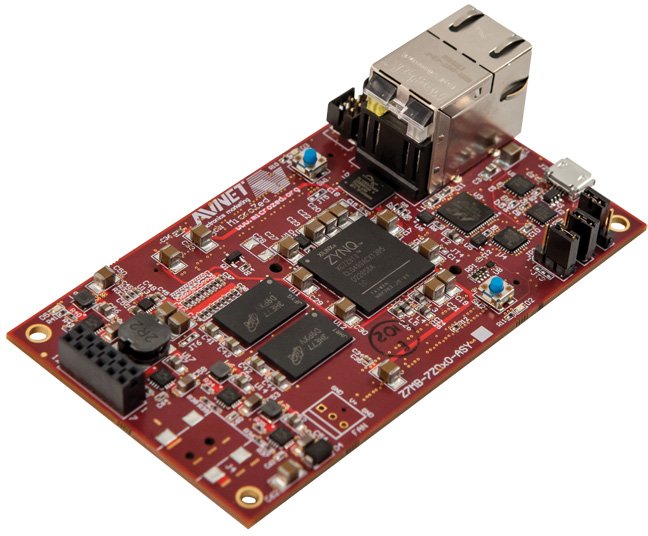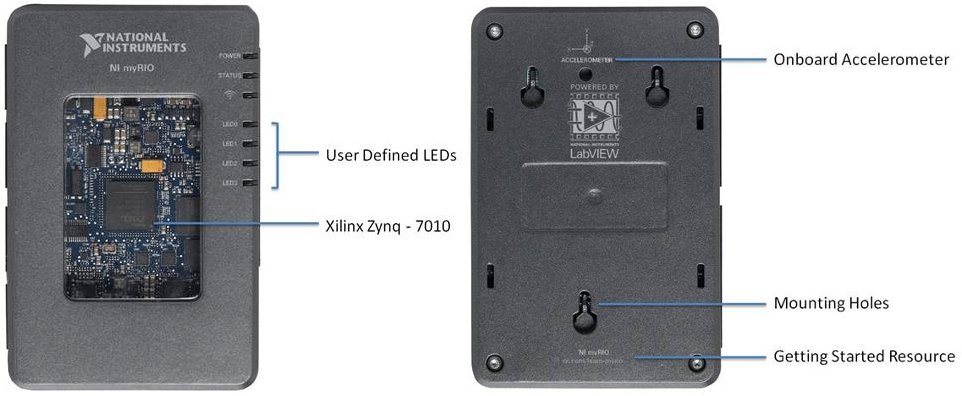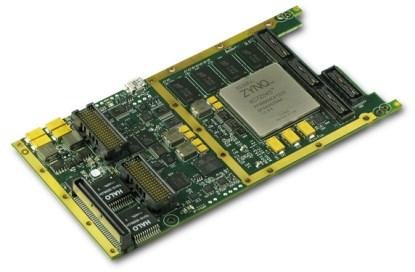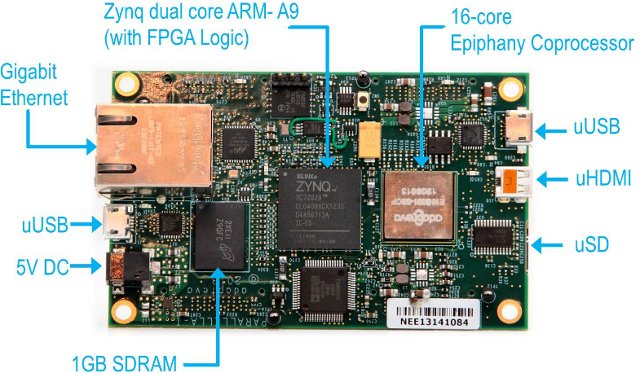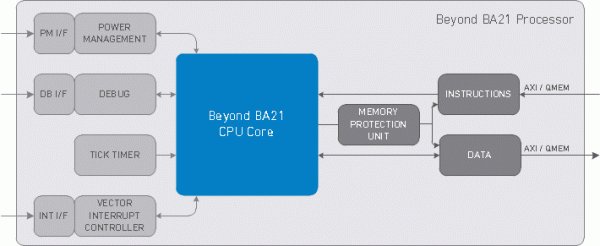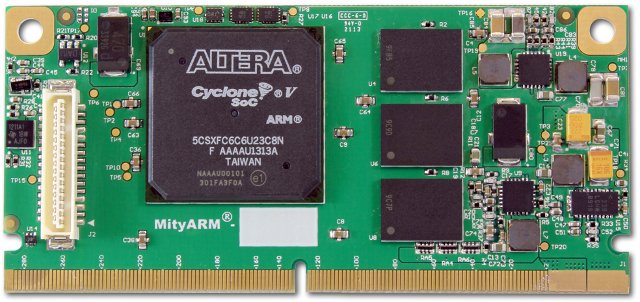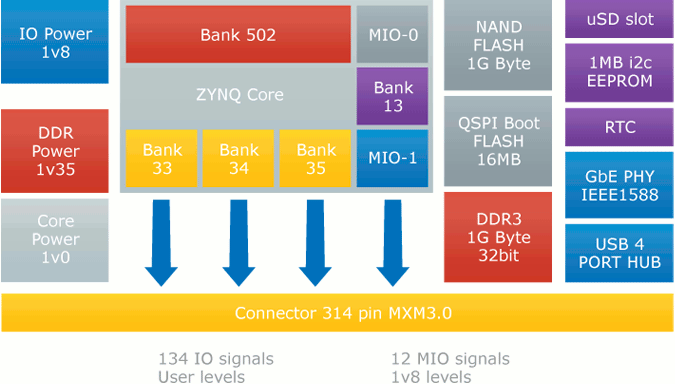ZedBoard is a low cost development board based on Xilinx Zynq-7020 SoC featuring two Cortex A9 cores and FPGA fabric, together with lots of ports and expansion I/Os, and running Linux. The problem is that “low cost” for this type of board still means $395 (or around $300 for academia), and you only get to this price because it’s been subsidized, and the normal price is actually $495… That’s why Avnet has just come with a new version of the evaluation kit called microZed that sells for $199 and targets applications such as general Zynq-7000 AP SoC evaluation and prototyping, embedded system-on-module (SOM) applications, embedded vision, test & measurement, motor control and software-defined radio. MicroZed technical specifications: SoC – Xilinx XC7Z010-1CLG400C (Zynq-7010) System Memory – 1 GB of DDR3 SDRAM Storage – 128 Mb of QSPI Flash + Micro SD card interface Connectivity 10/100/1000M Ethernet USB 2.0 USB-UART User I/O […]
NI myRIO is an Education Platform Powered by Xilinx Zynq-Z7010
National Instruments has been working on a device called NI myRIO, an hardware & software platform that aims at giving engineering students the ability to design real systems quickly for automation, robotics, data logging or embedded systems. The hardware is based on Xilinx Zynq-7010 with a dual-core ARM Cortex-A9 processor and an FPGA with 28,000 programmable logic cells, and features 10 analog inputs, 6 analog outputs, audio I/O channels, and up to 40 lines of digital input/output (DIO). NI myRIO Hardware Specifications: SoC – Xilinx Zynq-7010 with a dual core Cortex A9 processor and FPGA with 28,000 cells System Memory – Unknown Storage – Unknown Expansion Ports: myRIO exPansion Ports (MXP) – Two identical ports (MXP A and MXP B) with 4 analog inputs, 6 digital inputs/outputs, 2 analog outputs, 1 quad encoder, 3 PWMs, 1 UART, 1 I2C and 1 SPI by default. Ports configuration is customizable with Labview […]
$359 Red Pitaya Board Combines an Oscilloscope, a Spectrum Analyser, a Waveform Generator and More
If you need to setup an electronics lab, the cost of equipment such as an oscilloscope, spectrum analyzer, can quickly add up and become expensive. There are already some attempts at low cost measurement devices such as the $35 ExpEyes Junior or pocket size digital storage oscilloscopes (~$200), but those are far from the performance achieved with regular measurement devices. Red Pitaya measurement board brings the performance level and flexibility a bit higher, and stays relatively low cost at $359, with a Linux-based solution based on Xilinx Zynq dual Cortex A9 + FPGA SoC. Hardware Specifications: SoC – Xilinx Zynq Z7010 dual core Cortex A9 CPU + FPGA System Memory – 1GB DDR2 RAM Storage – microSD card slot (For system and FPGA images, and data) Connectivity – 10/100M Ethernet USB – 2x micro USB ports (1 for power, 1 for console), and 1x USB 2.0 Host port Signals: 2x […]
Alpha Data ADM-XRC-7Z1 XMC Mezzanine Card Powered by Xilinx Zynq SoC
Alpha Data, a company providing solutions for compute intensive applications, has announced the ADM-XRC-7Z1, an XMC board powered by Xilinx Zynq-7045 or Zynq-7100 Cortex A9 + FPGA SoC targeting application such as software-defined radio, radar and sonar processing, image processing and machine vision. If you are like me, and have never heard about XMC mezzanine cards before, here’s what Wikipedia has to say about it: XMC, or Switched Mezzanine Card, is a PCI Mezzazine Card (PMC) with high-speed serial fabric interconnect defined by the VITA 42 standard. XMC specifies a 5th connector (“P15”) that supports PCI Express (VITA 42.3) or other high speed serial formats such as Serial RapidIO (VITA 42.2) and Parallel RapidIO (VITA 42.1). VITA (VMEbus International Trade Association) is an organization developing and promoting open technology standards that you can download for a fee. Here are the specifications of the board: SoC – Xilinx Zynq-7045 or Zynq-7100 dual […]
$99 Parallella Supercomputer is Now Open Source Hardware
Parallella is a low cost supercomputer designed by Adapteva using Xilinx Zynq-7010/7020 FPGA+2x Cortex A9 SoC combined with Adapteva Ephipany 16 or 64 cores epiphany coprocessor. The project had a successful kickstarter campaign which allowed then to provide the 16-core version for $99, and the 64-core version for $750. The board will soon be shipped to people who pledged on kickstarter, and one of the promise of the campaign was to fully open source the platform, and today, they just fulfilled that. Before going into the details of the open source release, let’s have a look at the specs: SoC – Xilinx Zynq7000 Series (Z-7010 or Z-7020) Dual-Core ARM Cortex A9 with 512KB L2 Shared Cache Coprocessor – Epiphany Multicore Coprocessor. The Parallella-16 board includes the 16-core Epiphany-III processor The Parallella-64 board includes the 64-core Epiphany-IV processor System Memory – 1024MB DDR3L Boot Flash – 128 Mb QSPI Flash Indicators […]
Beyond Semiconductor Announces BA21 Processor Core for Embedded MCUs
Beyond Semiconductor, a Ljubljana, Slovenia based company, has recently announced BA21, a 32-bit processor core, with 2.5 Coremark per megahertz, and clocked up to 125 MHz, that’s roughly equivalent to a Cortex M3 core @ 120 MHz. Target applications include mixed signal embedded processing, wireless communications ICs (e.g. Bluetooth, Zigbee, GPS), industrial Microcontrollers, and battery-powered or ultra-low-cost devices.If you’ve never heard about Beyond Semi, you may want to read my previous article about their BA25 core (Cortex A7/A8 equivalent) for a bit more details about the company. Here are the key features of BA21 core: 32-bit Processor Small silicon footprint (less than 10k gates) for lower leakage and dynamic CPU power Two-stage pipeline architecture Extreme Code Density for lower instruction fetching energy Advanced power management Dynamic clock gating and power shut-off of unused units Software- and hardware-controlled clock frequency Wake-up on tick timer or external interrupt Performance Up to 2.5 […]
Critical Link MityARM-5CSX CoM Powered by Altera Cyclone V SoC
Earlier this week, I wrote about EnSilica eSi-ZM1, a system-on-module based on Xilinx Zynq7000 Extensible Processing Platform that comes with a dual core ARM Cortex A9 and FPGA fabric. It turns out Xilinx is not the only game in town, and Altera’s Cyclone V SoC, announced last December, also includes a dual core ARM Cortex A9 processor with Altera FPGA logic, and Critical Linux recently announced MityARM-5CSX computer-on-module based on this platform. Target applications include machine vision, scientific imaging, motor control, medical imaging and instrumentation, test and measurement, industrial instrumentation, as well as a military & aerospace. MityARM-5CSX specifications: SoC – Altera Cyclone V SX-U672 with FPGA logic and dual-core ARM Cortex-A9 up to 800MHz System Memory – 1GB DDR3 RAM, and 256MB DDR3 FPGA RAM (optional) Storage – 32MB QPSI NOR flash FPGA I/O fabric: PCIe hard core Up to 145 user-programmable I/O lines (including several 875MHz SerDes lanes) […]
EnSilica eSi-ZM1 System-on-Module Features Xilinx Zynq XC7Z020 SoC
EnSilica has introduced the eSi-ZM1 SoM powered by Zynq ZC7Z020 SoC featuring 2 ARM Cortex A9 core, and an Artix-7 FPGA with 85K logic cells. The module also comes with 1GB RAM, 1GB NAND flash, and 16MB QSPI Boot Flash. ZC7Z020 SoC is notably used in ZedBoard development board, so if you have developed an application around this board, and want to commercialize it, using eSi-ZM1 module with your own custom baseboard could be an option. eSi-ZM1 system-on-module specifications: SoC – Xilinx Zynq XC7Z020 dual-core Cortex A9 processor @ 666 MHz, 85 K logic cells, 560 KB block RAM, and 220 DSP Slices. CLG484 package type System Memory – 1 GB, 1.35 V, 32-bit wide DDR3 SDRAM @ 533 MHz Storage: 1 GB, 1.8 V, 8-bit wide NAND FLASH 16 MB QSPI flash 1 or 2 Kb I2C EEPROM (and not 1MB as mentioned in the block diagram ) uSD card […]


